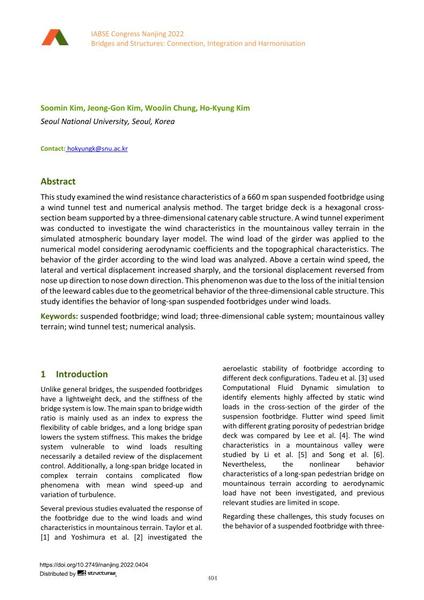The Behavior of Long-span Suspended Footbridge Under Wind Load

|
|
|||||||||||
Bibliographic Details
| Author(s): |
Soomin Kim
(Seoul National University, Seoul, Korea)
Jeong-Gon Kim (Seoul National University, Seoul, Korea) WooJin Chung (Seoul National University, Seoul, Korea) Ho-Kyung Kim |
||||
|---|---|---|---|---|---|
| Medium: | conference paper | ||||
| Language(s): | English | ||||
| Conference: | IABSE Congress: Bridges and Structures: Connection, Integration and Harmonisation, Nanjing, People's Republic of China, 21-23 September 2022 | ||||
| Published in: | IABSE Congress Nanjing 2022 | ||||
|
|||||
| Page(s): | 404-409 | ||||
| Total no. of pages: | 6 | ||||
| DOI: | 10.2749/nanjing.2022.0404 | ||||
| Abstract: |
This study examined the wind resistance characteristics of a 660 m span suspended footbridge using a wind tunnel test and numerical analysis method. The target bridge deck is a hexagonal cross- section beam supported by a three-dimensional catenary cable structure. A wind tunnel experiment was conducted to investigate the wind characteristics in the mountainous valley terrain in the simulated atmospheric boundary layer model. The wind load of the girder was applied to the numerical model considering aerodynamic coefficients and the topographical characteristics. The behavior of the girder according to the wind load was analyzed. Above a certain wind speed, the lateral and vertical displacement increased sharply, and the torsional displacement reversed from nose up direction to nose down direction. This phenomenon was due to the loss of the initial tension of the leeward cables due to the geometrical behavior of the three-dimensional cable structure. This study identifies the behavior of long-span suspended footbridges under wind loads. |
||||
| Keywords: |
wind tunnel test numerical analysis wind load suspended footbridge three-dimensional cable system mountainous valley terrain
|
||||
| Copyright: | © 2022 International Association for Bridge and Structural Engineering (IABSE) | ||||
| License: | This creative work is copyrighted material and may not be used without explicit approval by the author and/or copyright owner. |
||||


